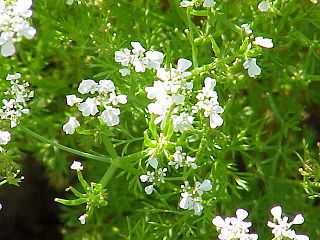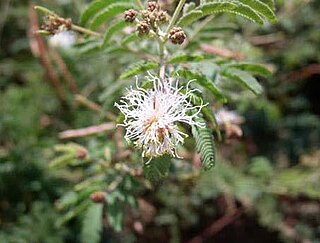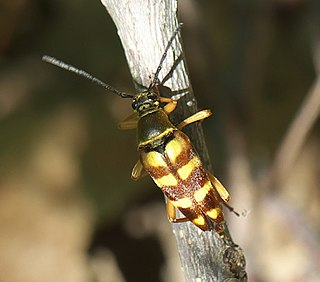
Anthriscus (chervils) is a common plant genus of the family Apiaceae, growing in Europe and temperate parts of Asia. It comprises 15 species. The genus grows in meadows and verges on slightly wet porous soils. One species, Anthriscus cerefolium is cultivated and used in the kitchen to flavor foods.

The dwarf fat-tailed mouse opossum, also known as the velvety fat-tailed opossum is an opossum species from South America. It is endemic to Brazil, where it is found in cerrado and caatinga habitats. Its head-and-body length is about 141-212 mm, and its tail length is about 73-85 mm. Its diet is 44% arthropods; 75% of its diet consists of animals and animal products. Its ventral fur is entirely gray-based. Its hind foot is less than 14 mm, which is short for the genus.

Pachnodus velutinus was a species of air-breathing land snail, a terrestrial pulmonate gastropod mollusk in the family Cerastidae. This species was endemic to the Seychelles. It is now extinct.
Pentaspadon is a genus of plants in the family Anacardiaceae.

Ceanothus velutinus, with the common names snowbrush ceanothus, red root, and tobacco brush, is a species of shrub in the family Rhamnaceae. It is native to western North America from British Columbia to California to Colorado, where it grows in several habitat types including coniferous forest, chaparral, and various types of woodland.

Spodiopogon is a genus of Asian plants in the grass family.

Ernest Charles Nelson's taxonomic arrangement of Adenanthos was the first modern-day arrangement of that plant genus. First published in his 1978 Brunonia article "A taxonomic revision of the genus Adenanthos (Proteaceae)", it superseded the arrangement of George Bentham, which had stood for over a hundred years. It was updated by Nelson in his 1995 treatment for the Flora of Australia series of monographs.

Adenanthos macropodianus, commonly known as gland flower, or Kangaroo Island gland flower, is a species of shrub in the family Proteaceae. It is endemic to Kangaroo Island in South Australia. First published as a variety of A. sericeus in 1870, it was promoted to species rank in 1978.
Adenanthos ileticos is a species of shrub in the family Proteaceae. It has roughly triangular, lobed leaves, and pale pink-red and cream, inconspicuous flowers. A rare species, it is known only from a single location in the south-west of Western Australia. It was discovered in 1968, and immediately brought into cultivation, but it would not be formally published and named until a decade later.

Adenanthos sect. Adenanthos is a taxonomic section of the flowering plant genus Adenanthos (Proteaceae). It comprises 29 species. The centre of diversity is southwest Western Australia, with two species extending into South Australia and western Victoria.
Adenanthos labillardierei is a species of erect shrub endemic to the slopes of the Barren Ranges in the Fitzgerald River National Park in southwest Western Australia.
Tischeria ceanothi is a moth of the family Tischeriidae. It is known from California and Nevada in the United States.

Iridopsis clivinaria, the mountain mahogany looper moth, is a moth of the family Geometridae. It is found from British Columbia south to California and east to Idaho, Colorado and Arizona.

Desmanthus velutinus is a species of flowering plant in the legume family known by the common name velvet bundleflower. It is native to New Mexico and Texas in the United States and Coahuila in Mexico. It may also occur in Oklahoma.
Gonystylus velutinus is a tree in the family Thymelaeaceae.
Chisocheton velutinus is a tree in the family Meliaceae. The specific epithet velutinus is from the Latin meaning "velvety", referring to the indumentum of the leaves and fruits.
Adenanthos velutinus, or velvet woollybush, is a shrub of the family Proteaceae native to Western Australia.

Typocerus velutinus, known generally as the banded longhorn or cerambycid beetle, is a species of flower longhorn in the family of beetles known as Cerambycidae. It is found in North America.
Goniothalamus velutinus is a species of plant in the family Annonaceae. It is native to Borneo. Herbert Airy Shaw, the English botanist who first formally described the species, named it after the dense velvety hair on its branchlets and petioles.
The Papillate catfish is a species of catfish in the family Ariidae. It was described by Max Carl Wilhelm Weber in 1907, originally under the genus Hemipimelodus. It inhabits freshwater lakes and rivers in New Guinea. Its diet includes mayflies and other terrestrial and aquatic insects, detritus, benthic algae, and crustaceans.










